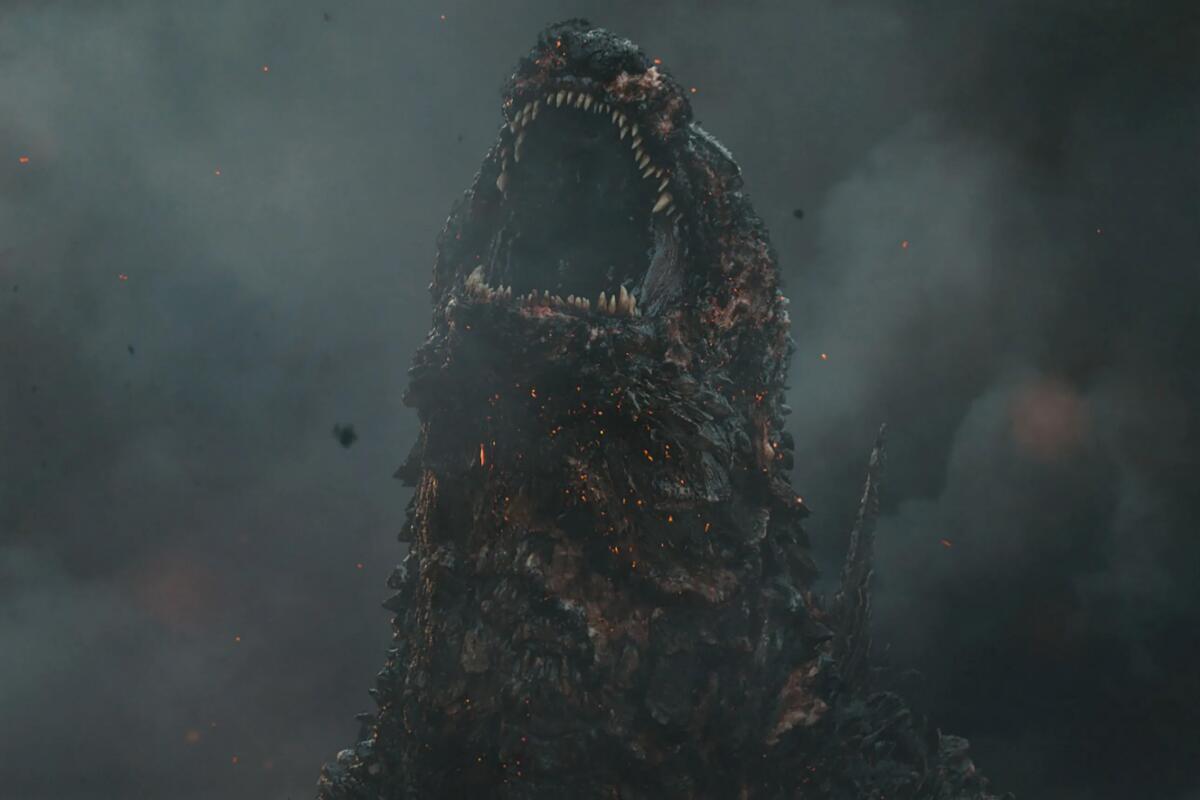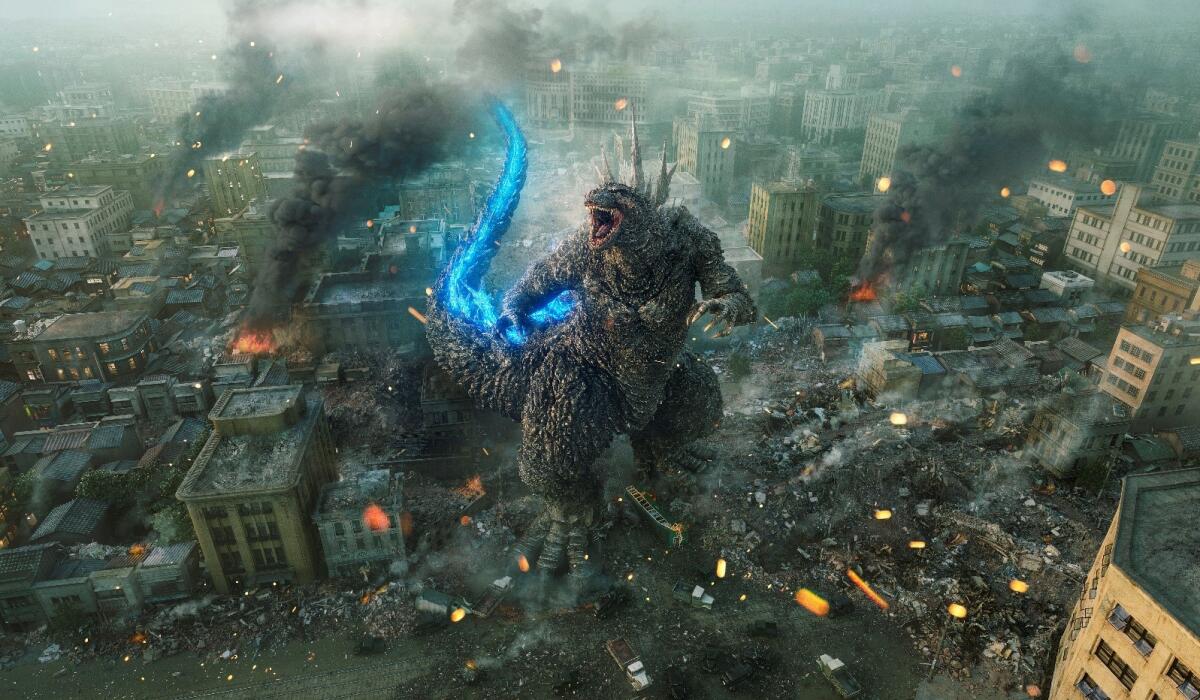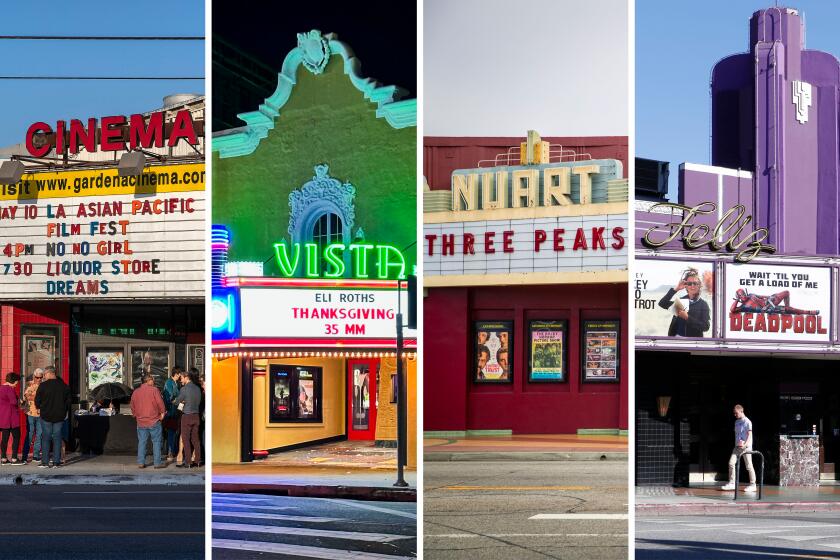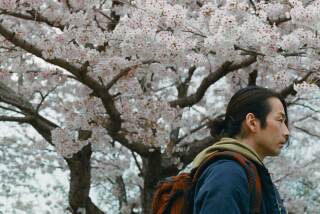Review: In ‘Godzilla Minus One,’ a sizzling nuclear horror reemerges from the deep in earnest

- Share via
Back in 1954, just nine years after the atomic bombings of Hiroshima and Nagasaki, Japanese filmmaker Ishirō Honda and special effects designer Eiji Tsuburaya dreamed up a giant dinosaur-like creature that came from the depths of the ocean, mutated by nuclear radiation, a “kaiju” named Godzilla. The monster was a metaphor for Japanese atomic trauma, and the film, produced and distributed by Toho, was a hit, spawning the longest-running film franchise of all time.
Some 70 years later, the 33rd Toho Godzilla film (the 37th in the franchise), “Godzilla Minus One,” written and directed by Takashi Yamazaki, brings Godzilla back to its Japanese roots (it’s the first Toho Godzilla film since 2016’s “Shin Godzilla”), as well as its World War II roots. Taking place during the immediate post-war period in 1945, the film reckons with more than just the metaphorically monstrous nuclear fallout of the war, but also the devastatingly human emotional effects. When this monster surfaces, glowing neon blue from the nuclear testing at Bikini Atoll, it unearths all of the repressed shame and trauma of Japanese veterans, specifically a failed kamikaze pilot, Koichi (Ryunosuke Kamiki).
Koichi has already encountered Godzilla by the time the monster stomps its way into Tokyo. During his failed kamikaze flight, he stopped on Odo Island for assistance, where the mythical creature came ashore to wreak havoc. Having already fled his mission, Koichi freezes in the face of this monster, failing to shoot it and unable to assist his new friends, the airplane mechanics, who perish in the attack.
Two years later, Godzilla rears its head again from the ocean depths off Japan, mad as hell. Koichi has now formed an unlikely family unit with Noriko (Minami Hamabe), and a young child, Akiko (Saki Nagatani), who was orphaned in the bombing of Tokyo. He’s been working with a crew to clear mines from the ocean floor, and they are conscripted into tangling with Godzilla, who has been chomping through heavy cruisers and blasting them with atomic heat rays, before heading to shore to wreck its way through a Tokyo still struggling to get back on its feet.

The scrappy crew aboard this wooden boat will remind audiences of “Jaws,” as will the Japanese government’s unwillingness to warn citizens about the impending threat, much like the mayor of Amity Island in Steven Spielberg’s shark movie. There are also other references to “Jaws,” like the dead deep-sea fish that bubble to the surface as a harbinger of Godzilla’s arrival, and Yamazaki has said that he was inspired by that film.
Yamazaki’s script does reckon with the lasting effects of World War II in Japan, and while the nuclear mutation of Godzilla is part of the plot, the themes of “Godzilla Minus One” are focused more on the Japanese government, including their failure to protect its citizens from this threat, as well as the oppressive imperial regime that pressured young men into suicide missions during the war.
It’s a group of private naval vets who end up taking on Godzilla — not the government — while Koichi struggles with his own shame over failing to stop the monster back on Odo. It’s not until he can finally fulfill his mission that he can be free of this shame, and it takes Godzilla’s destructive arrival to bring that into focus for him.
We’ve mapped out 27 of the best movie theaters in L.A., from the TCL Chinese and the New Beverly to the Alamo Drafthouse and which AMC reigns in Burbank.
Yamazaki’s take on Godzilla is classical, utilizing the giant kaiju as a metaphor for social commentary, and his aesthetic is classical as well, combining a retro 1940s style with cutting-edge visual effects for one of the most striking Godzilla monsters we’ve seen in years. The way its craggy fins break the surface of the ocean is almost photorealistic, and when Godzilla’s atomic-powered glowing spine bursts with power, it’s breathtakingly beautiful.
While some of the emotional beats are a bit pat, the way Yamazaki grapples with the wider nuances of wartime trauma feels fresh and innovative, if not radical, proving that even after seven decades of wreckage, this iconic kaiju still has plenty of fuel in the reactor.
Katie Walsh is a Tribune News Service film critic.
'Godzilla Minus One'
In Japanese with English subtitles
Rating: PG-13, for creature violence and action
Running time: 2 hours, 5 minutes
Playing: In wide release Dec. 1
More to Read
Only good movies
Get the Indie Focus newsletter, Mark Olsen's weekly guide to the world of cinema.
You may occasionally receive promotional content from the Los Angeles Times.











